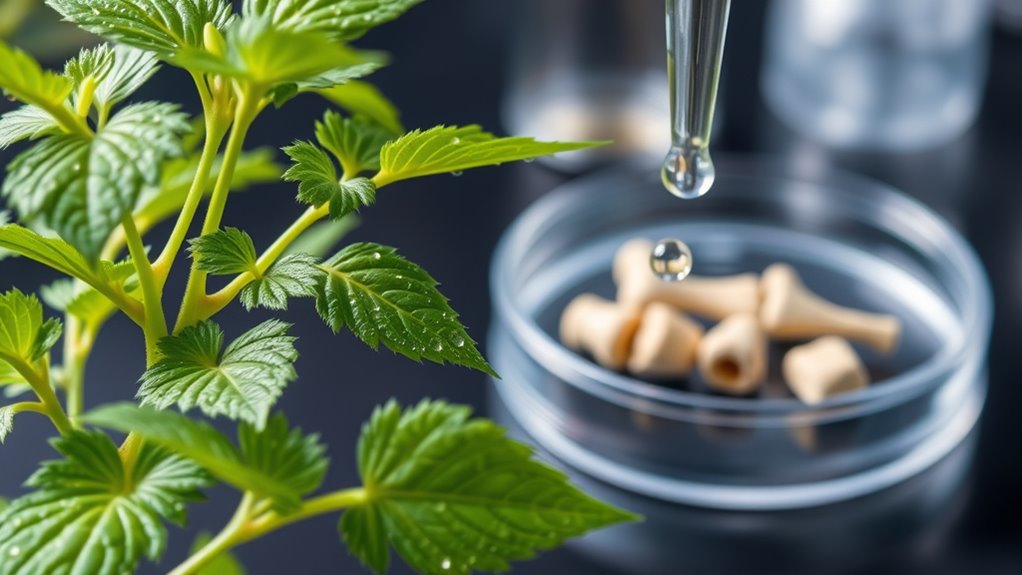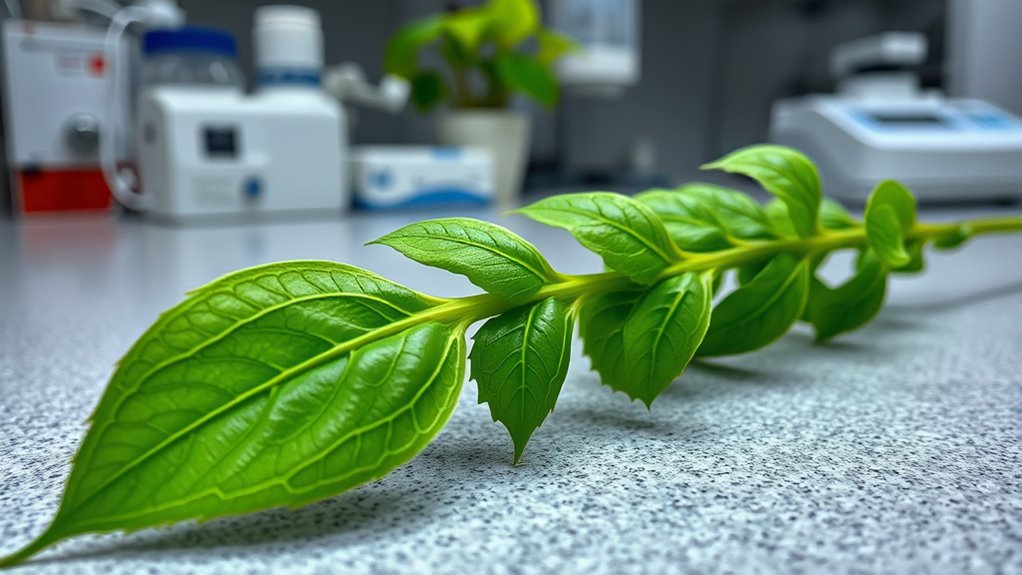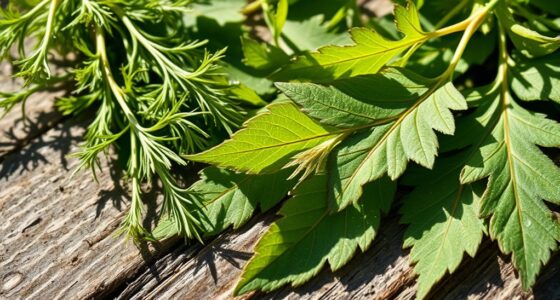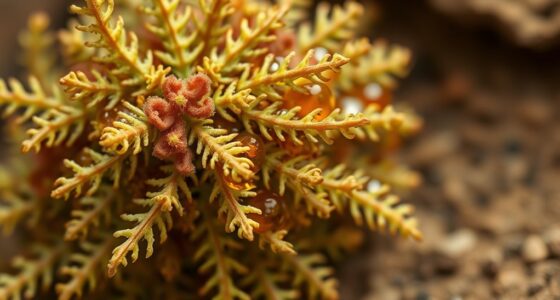Cissus quadrangularis has shown scientific evidence supporting its role in enhancing bone healing and influencing parathyroid hormone levels, which are essential for calcium regulation and bone health. This plant’s phytochemicals promote bone regeneration, stimulate osteoblastic activity, and help maintain hormonal balance. Studies suggest it can improve bone density and support recovery after fractures. To understand how these mechanisms work together and the potential for safe use, keep exploring further details.
Key Takeaways
- Cissus quadrangularis contains phytochemicals that support osteogenesis and may modulate parathyroid hormone (PTH) levels for bone health.
- Animal studies indicate extracts can influence PTH secretion, aiding calcium regulation and enhancing bone regeneration.
- Research shows Cissus supplementation can increase bone mineral density and stimulate osteoblastic activity.
- Variability in clinical outcomes is influenced by genetic, environmental, and dosage factors affecting bone healing efficacy.
- Scientific evidence suggests Cissus supports bone repair, possibly through PTH pathway modulation, but further studies are needed for conclusive proof.
Overview of Cissus Quadrangularis and Its Traditional Uses

Cissus quadrangularis, a plant native to Africa and Asia, has been valued for centuries for its medicinal properties. In traditional medicine, people use it as a powerful plant-based remedy to treat various ailments, including wounds, fractures, and digestive issues. Its leaves and stems are often prepared as powders, teas, or extracts, believed to promote healing and reduce inflammation. This long-standing use highlights its role in natural healing practices across different cultures. Many rely on Cissus quadrangularis to support bone health and recovery, making it a key ingredient in traditional remedies. Its historical significance underscores its reputation as a natural solution for improving overall health and accelerating the healing process. Additionally, scientific research has begun to explore traditional uses and validate its potential benefits for bone repair and regeneration, with some studies indicating its ability to influence bone healing mechanisms and enhance parathyroid hormone levels to promote bone growth.
Biological Mechanisms Underlying Bone Regeneration

Understanding how Cissus Quadrangularis promotes bone healing involves exploring its osteogenic effects, which encourage new bone formation. It also influences parathyroid hormone regulation, helping to balance calcium levels essential for regeneration. Additionally, it activates specific bone cell pathways that accelerate the repair process, making it a promising natural aid for bone health. Furthermore, parathyroid hormone regulation plays a crucial role in maintaining calcium homeostasis, which is vital for effective bone regeneration. The modulation of bone remodeling processes is another critical aspect through which Cissus Quadrangularis supports skeletal repair and regeneration. Ongoing research highlights the importance of AI safety measures to ensure reliable outcomes in biomedical applications.
Cissus Quadrangularis’ Osteogenic Effects
Cissus Quadrangularis promotes bone regeneration by actively stimulating osteogenic processes within the body. Your genetic factors can influence how effectively this plant enhances bone formation, as some individuals may respond better based on genetic predispositions. Additionally, dietary influences play a pivotal role; adequate intake of nutrients like calcium and vitamin D can boost the osteogenic effects of Cissus Quadrangularis. The plant’s bioactive compounds, such as flavonoids and triterpenoids, work together to promote osteoblast proliferation and differentiation, leading to new bone tissue development. By supporting these cellular activities, Cissus Quadrangularis helps accelerate healing, especially when combined with favorable genetics and proper nutrition. This synergy emphasizes the importance of personalized approaches to maximizing its osteogenic potential. Moreover, understanding biological mechanisms underlying bone regeneration can guide targeted interventions for more effective healing outcomes. Considering the WWE Raw’s financial impact, the economic significance of bone health and recovery is increasingly recognized in sports medicine and rehabilitation. Additionally, recent research highlights how growth factors play a crucial role in enhancing osteogenesis, further supporting the therapeutic potential of natural supplements like Cissus Quadrangularis. Moreover, advancements in regenerative medicine are opening new avenues for combining natural compounds with innovative therapies to optimize bone healing.
Parathyroid Hormone Regulation
Parathyroid hormone (PTH) plays a crucial role in regulating bone remodeling and regeneration by controlling calcium and phosphate balance in your body. Proper hormonal balance ensures that bone formation and resorption stay in harmony, supporting healing processes. PTH influences osteoblasts and osteoclasts, managing how bones rebuild after injury. When considering supplement safety, it’s important to understand how PTH responds to various treatments and nutrients like Cissus Quadrangularis. Maintaining ideal PTH levels promotes effective bone regeneration without disrupting hormonal balance. Here’s a simplified view:
| Hormone Level | Effect on Bone | Outcome |
|---|---|---|
| Elevated PTH | Stimulates osteoclasts | Bone resorption increases |
| Normal PTH | Balances osteoblasts and osteoclasts | Healthy bone turnover |
| Low PTH | Reduces bone resorption | Potential for decreased bone healing |
Additionally, understanding the Gold IRA rules and potential scams can help investors protect their assets while supporting their long-term financial health. Proper regulation of parathyroid hormone is essential for optimal bone healing and maintenance. The hormonal regulation of PTH is vital for coordinating bone repair processes effectively.
Bone Cell Activation Pathways
Bone regeneration relies on the activation of specific cellular pathways that coordinate the growth and differentiation of osteoblasts and osteoclasts. You should understand that genetic factors influence these pathways, determining how efficiently your bones heal. For example, certain gene variations can enhance or impair signaling mechanisms like the RANK/RANKL/OPG pathway, which controls osteoclast activity. Dietary influences also play a vital role; nutrients like calcium, vitamin D, and protein support the activation of bone cells. These factors modulate signaling cascades such as Wnt/β-catenin, promoting osteoblast proliferation and maturation. Recognizing how genetic predispositions and diet impact these activation pathways helps you appreciate the complexity of bone regeneration and the potential to optimize healing through targeted interventions.
Key Components of Cissus Quadrangularis and Their Effects on Bone Health

You should know that Cissus Quadrangularis contains active phytochemicals like flavonoids and triterpenoids that support bone health. These compounds contribute to bone regeneration by reducing inflammation and stimulating cell growth. Understanding how these components work can help you appreciate its potential for healing fractures faster. Additionally, studies indicate that Cissus Quadrangularis may enhance calcium absorption and mineralization, further strengthening bones bone regeneration. Moreover, the presence of bioactive compounds in Cissus Quadrangularis plays a crucial role in promoting overall skeletal health and recovery. Incorporating holistic healing methods such as yoga practices that improve flexibility and reduce stress can complement the benefits of Cissus Quadrangularis for bone health. Exploring how nanotechnology could potentially improve delivery systems for such herbal supplements may further enhance their efficacy and absorption. Recent research also highlights the importance of nutrient absorption in maximizing the therapeutic effects of herbal interventions.
Active Phytochemicals Identified
Cissus quadrangularis contains a rich array of active phytochemicals that contribute to its bone-healing properties. Among these, plant alkaloids stand out for their potential to stimulate bone regeneration and reduce inflammation. These compounds interact through complex phytochemical interactions, enhancing the plant’s overall therapeutic effects. You’ll find that alkaloids work synergistically with other phytochemicals like flavonoids and triterpenoids, amplifying their positive impact on bone health. This intricate network of phytochemicals not only supports mineralization but also promotes cellular growth and repair. Additionally, research indicates that these phytochemicals may influence parathyroid hormone levels, which play a crucial role in calcium regulation and bone density. Recognizing the phytochemical interactions within Cissus quadrangularis helps explain why it effectively accelerates bone healing. The interplay of plant alkaloids and other phytochemicals is key to *accessing* its full potential as a natural remedy for bone injuries. Moreover, understanding these active compounds can guide future research into optimizing its therapeutic applications.
Impact on Bone Regeneration
Several key components in Cissus quadrangularis directly influence bone regeneration by stimulating cellular activity and enhancing mineralization. As a popular ingredient in dietary supplements and a staple in traditional medicine, it promotes healing by encouraging osteoblast proliferation and accelerating new bone formation. These components work synergistically to improve calcium absorption and support collagen synthesis, essential for strong bones. You can leverage this herb’s natural properties to aid recovery from fractures or bone defects. Its impact on bone regeneration is well-documented, making it a valuable adjunct in bone health management. Incorporating Cissus quadrangularis into your routine may boost your body’s ability to repair and rebuild bone tissue efficiently. Its traditional use and scientific backing highlight its potential role in supporting skeletal integrity and healing processes.
Scientific Studies on Cissus Quadrangularis and Bone Density Improvement

Numerous scientific studies have explored how Cissus quadrangularis can enhance bone density and support healing processes. As an herbal supplement, it has shown promising results in increasing mineral content and improving bone strength. In controlled experiments, subjects taking Cissus quadrangularis experienced significant gains in bone density compared to placebo groups. The extract appears to stimulate osteoblastic activity, promoting new bone formation. Research also suggests that its bioactive compounds help reduce bone resorption, maintaining a healthier bone matrix. These findings support the idea that Cissus quadrangularis can be an effective natural intervention for improving bone health. If you’re seeking a supplement to strengthen bones, this evidence underscores its potential as a valuable addition to your regimen.
The Role of Parathyroid Hormone in Bone Metabolism

Parathyroid hormone (PTH) plays a key role in bone remodeling by stimulating osteoblasts and osteoclasts to balance bone formation and resorption. It also helps regulate calcium levels in your blood, ensuring proper mineralization. Understanding how PTH influences these processes can shed light on its importance in bone healing and health.
PTH and Bone Remodeling
Parathyroid hormone (PTH) plays a crucial role in maintaining calcium balance and regulating bone remodeling. It acts as a key mediator in hormonal regulation, balancing bone resorption and formation to guarantee stable calcium levels. PTH influences osteoclast activity, breaking down bone tissue to release calcium into the bloodstream, especially during periods of nutritional deficiency or low calcium intake. Its effects are tightly controlled by feedback mechanisms that respond to serum calcium levels. Nutritional factors, like adequate vitamin D and calcium intake, modulate PTH’s activity, optimizing bone health. Understanding this dynamic helps you recognize how PTH adapts bone remodeling processes to meet physiological needs, guaranteeing skeletal integrity and mineral homeostasis. This regulation underscores PTH’s essential role in maintaining healthy bones throughout your life.
PTH’s Effect on Osteoblasts
While PTH is well-known for stimulating bone resorption, it also plays a pivotal role in promoting bone formation by directly affecting osteoblasts. PTH influences these cells by encouraging their cellular differentiation and activity, which supports bone growth. This dual role helps maintain hormonal balance in bone metabolism, balancing resorption and formation. When PTH binds to osteoblasts, it activates signaling pathways that increase their proliferation and matrix production, fostering new bone tissue. To understand better, consider this table:
| Effect of PTH on Osteoblasts | Resulting Action |
|---|---|
| Promotes cellular differentiation | Enhances osteoblast maturity |
| Stimulates matrix synthesis | Builds new bone matrix |
| Increases proliferation | Expands osteoblast population |
| Regulates signaling pathways | Maintains hormonal balance |
This process underscores PTH’s essential role in bone health and cellular differentiation.
PTH and Calcium Regulation
PTH plays a key role in maintaining calcium balance in your body by regulating bone metabolism. It increases blood calcium levels by stimulating bone resorption, which can influence bone density over time. PTH also enhances calcium absorption in your intestines by activating vitamin D, ensuring your body has enough calcium for various functions. When calcium levels drop, PTH secretion rises, prompting your bones to release calcium to restore balance. This hormone also acts on your kidneys to reduce calcium excretion, helping retain more calcium in your system. Understanding this regulation is vital because it directly impacts your bone health and the body’s ability to maintain proper calcium levels. Proper PTH function keeps your bones strong and prevents conditions like osteoporosis.
Evidence Linking Cissus Quadrangularis to PTH Modulation

Research suggests that Cissus quadrangularis may influence parathyroid hormone (PTH) levels, which are essential in bone metabolism and calcium regulation. This plant contains bioactive plant-based compounds that could modulate hormonal interactions, potentially affecting PTH secretion. Evidence from animal studies indicates that extracts of Cissus quadrangularis can alter PTH levels, supporting its role in calcium homeostasis. To visualize these effects, consider the following:
| Effect on PTH | Mechanism of Action | Impact on Bone Health |
|---|---|---|
| Upregulation | Stimulates PTH release | Promotes calcium mobilization |
| Downregulation | Inhibits PTH secretion | Prevents excessive bone resorption |
| Balanced modulation | Maintains hormonal balance | Supports overall bone integrity |
This evidence suggests that plant-based compounds in Cissus quadrangularis may influence hormonal interactions, linking it to PTH modulation and bone health.
Clinical Trials and Human Research on Bone Healing Support

Several clinical trials have evaluated the effectiveness of Cissus quadrangularis in promoting bone healing in humans. These studies often consider variables like genetic predispositions and environmental factors that influence recovery. You’ll find that some trials report accelerated fracture healing and increased bone density with supplementation, while others highlight the importance of individual differences. The variability suggests that genetic factors may affect how well Cissus supports bone repair. Additionally, environmental factors such as nutrition and activity levels can impact results, emphasizing the need for personalized approaches. Overall, while promising, the human research underscores the complexity of bone healing and the influence of individual characteristics on treatment outcomes. These insights guide future clinical applications and personalized therapeutic strategies.
Potential Benefits and Risks of Using Cissus Quadrangularis for Bone Recovery

Cissus quadrangularis offers promising benefits for bone recovery, but it also carries potential risks that you should consider. Proper dosage considerations are vital to maximize benefits and minimize side effects. While many users tolerate it well, some may experience side effect profiles such as gastrointestinal discomfort, headaches, or allergic reactions. It is important to start with a low dose and monitor your response. Here’s a quick overview:
| Benefits | Risks |
|---|---|
| Accelerates bone healing | Potential gastrointestinal issues |
| Supports collagen synthesis | Allergic reactions |
| Enhances mineralization | Interactions with medications |
Being aware of these factors helps you weigh the potential gains against possible adverse effects, ensuring a safer approach to using Cissus quadrangularis for bone recovery.
Future Directions in Research on Natural Bone Regenerative Agents

As interest in natural bone regenerative agents grows, scientists are exploring innovative ways to enhance their effectiveness and safety. Future research may focus on developing synthetic alternatives that mimic the bioactivity of natural compounds like Cissus Quadrangularis. You might see more commercial formulations designed for standardized dosing and improved bioavailability, making treatments more accessible. Researchers are also investigating combination therapies that integrate natural agents with existing pharmaceuticals to boost healing outcomes. Additionally, exploring targeted delivery systems could optimize how these agents reach bone tissue, minimizing side effects. These advancements aim to bridge the gap between natural remedies and mainstream medical options, ensuring safer, more reliable options for bone regeneration. Ultimately, these directions could revolutionize the way you approach bone healing therapies.
Practical Considerations for Incorporating Cissus Quadrangularis Into Therapy

Incorporating Cissus Quadrangularis into therapy requires careful consideration of dosage, formulation, and individual patient factors. You should follow established dosing protocols to guarantee safety and efficacy, typically starting with a low dose and adjusting as needed. Be mindful of contraindication considerations, such as allergies or interactions with current medications. Always assess the patient’s health status and history before recommending Cissus Quadrangularis, especially in those with pre-existing conditions. Selecting the appropriate formulation—whether capsule, powder, or extract—can influence absorption and effectiveness. Additionally, monitor for any adverse effects during therapy. Clear communication about dosage and potential contraindications helps optimize outcomes while minimizing risks, ensuring that you incorporate Cissus Quadrangularis safely and effectively into your treatment plan.
Frequently Asked Questions
What Are the Potential Side Effects of Cissus Quadrangularis?
You might experience allergic reactions like rash, itching, or swelling when taking cissus quadrangularis. Gastrointestinal upset, such as nausea, diarrhea, or stomach pain, can also occur. While generally considered safe, some people may be sensitive to it. It’s best to start with a small dose and consult your healthcare provider if you notice any adverse effects or allergic symptoms.
How Does Cissus Quadrangularis Compare With Conventional Bone Healing Medications?
Compared to conventional bone healing medications, cissus quadrangularis offers comparable efficacy in promoting healing, but it often comes at a lower cost, making it more accessible. While traditional drugs may act faster or have extensive clinical backing, cissus provides a natural alternative with fewer side effects. You might find it appealing for its balance of effectiveness and affordability, especially if you prefer herbal options over synthetic medicines.
Can Cissus Quadrangularis Be Used Alongside Other Osteoporosis Treatments Safely?
Yes, you can use Cissus Quadrangularis alongside other osteoporosis treatments, but it’s crucial to evaluate combination therapy and supplement safety. Always consult your healthcare provider before combining supplements with prescribed medications to avoid interactions. While Cissus Quadrangularis shows promise, your doctor can help ensure it’s safe for you and won’t interfere with your existing treatment plan, helping you achieve the best outcomes.
Are There Specific Populations That Should Avoid Using Cissus Quadrangularis?
You should avoid using Cissus Quadrangularis if you’re pregnant or have kidney disease. While some believe it promotes bone healing, evidence is limited, and these populations face potential risks. Pregnancy restrictions exist because its safety for unborn babies isn’t established. If you have kidney disease, it might worsen your condition. Always consult your healthcare provider before starting any supplement, especially if you belong to these groups.
What Is the Optimal Dosage and Duration for Bone Healing Benefits?
For bone healing, you should follow dosage guidelines of 300-600 mg of Cissus Quadrangularis daily, taken in divided doses. The treatment duration typically spans 4 to 8 weeks, but it can vary based on your healing progress and doctor’s advice. Always start with the lowest effective dose and consult your healthcare provider to tailor the dosage and duration to your specific needs.
Conclusion
As you explore the potential of Cissus Quadrangularis for bone healing, remember that science is still uncovering its full capabilities. Could this natural remedy revolutionize recovery processes? While promising evidence points to its benefits, questions remain about ideal dosages and long-term effects. Stay tuned—what’s next might just change the way you approach bone health forever. The future of natural healing is closer than you think, and it’s full of possibilities waiting to be revealed.










